Successful delivery of ADEO deorbit modules to ISISPACE (NL)
HPS, one of the industrial pioneers worldwide in the development of sustainable use of space as a resource, is now the international gold standard in deorbit technology with its ADEO t dragsail product family for all satellite classes on LEO orbits. Satellite manufacturers and operators from the EU and Asia, Australia and America use an ADEO to reliably dispose of their spacecraft within the prescribed time window of a maximum of five years after the end of operation.
The most recent example: ISISPACE, Dutch satellite system integrator and space infrastructure provider, offers innovative turnkey solutions for space missions worldwide. Founded in Delft (NL) in 2006, the company specializes in the design, development, production, testing, launch and operation of small satellite platforms, both for individual missions and for constellations. The first ADEO for an ISISPACE satellite, an ADEO-Nx class module (only 745 gr., integrable into cubesat rails, TRL9-based, short delivery time), was delivered by the HPS project team at the end of June. Yesterday, July 1, 2025, the team personally handed over the CleanGreen Certificate on site in Delft to ISISPACE coinciding with the opening of the “Symposium on Space Sailing”
HPS CEO Ernst K. Pfeiffer hopes to celebrate the “possible start of a great collaboration with one of the most prominent and successful small satellite specialists in Europe”.
ISISPACE’s vertically integrated approach has been proven in more than 50 missions carried out in a wide range of solutions and applications, including Earth observation, IOD/IOV and many others. ISISPACE is headquartered in the Netherlands and employs around 120 people from more than 30 countries.

ADEO shines at the “International Symposium on Space Sailing” 2025!
ADEO shines at the “International Symposium on Space Sailing” 2025!
This week, at the “7th ISSS” in Delft (NL), HPS is proud to represent Europe’s leading deorbit solution: ADEO – the dragsail for a sustainable orbit.
With the presentation by our project manager Dorottya Milankovich on Day 1, June 30th, we’re showcasing:
- ADEO’s in-orbit flight heritage: now TRL9 after full deorbit of ION SCV-003 (2022–2024)
- Scalable dragsail modules available from 1.7 m² to 25 m² for satellite masses from 1 to 1500 kg
- New development ongoing on non-reflective ATOX-resistant sails, preserving dark skies and material performance
- Flight model of ADEO-L now ready for delivery to Redwire!
- ADEO derivates for small space debris in-situ measurement
- ADEO also applicable for Solar Sailing Missions.
HPS CEO on site: “We are proud to be part of this very specialised space sailing family, ranging from solar sail developers to dragsail suppliers, from radiation scientists to sailing simulation experts.”
In total 82 participants from all over the world listened on site and via online, from USA to Philippines, from NASA to TU Delft.
This Symposium proved:
ADEO is not just a product – HPS is one of the world market leaders for deorbit dragsail modules.
Let’s sail toward a cleaner orbit!
#ADEO #Dragsail #ZeroDebris #CleanSpace #SpaceDebris #ISSS2025 #SpaceSustainability #HPS #SpaceTech #Delft #TUDelft #LEO #SpaceSailing #ESA #SatelliteDeorbiting #Deployables #SolarSailing


Ernst K. Pfeiffer: Summary of the Zero Debris Symposium and Workshop on the Zero Debris Booklet – an ESA/ESOC initiative in Darmstadt
Ernst K. Pfeiffer: Summary of the Zero Debris Symposium and Workshop
Great: the Zero-Debris Symposium and Workshop on the Zero-Debris Booklet brought a full house to ESA’s European Space Operation Center from June 10 to 12. The program covered all relevant aspects of the topic with slots for exchanging experiences on developments over the last 12 months, panel discussions such as “Zero Debris Progress & Challenges” and presentations such as the one by HPS CEO Ernst K. Pfeiffer on “How we work with the Zero Debris Booklet”. HPS High Performance Space Structure Systems GmbH is one of the central suppliers in this “clean space” sector – but not only that: it is also one of the driving industrial forces when it comes to making space travel sustainable. To this end, the company has been investing heavily in corresponding technologies for over ten years and today covers the demand for towing sail modules (ADEO), is working on deployable membranes for the in-situ measurement of small debris (SAILOR) and has recently developed non-reflective films (ProFilm) for “dark skies”. At the end of the event, Pfeiffer summarized his summary in the following positions:
- The Zero Debris Charter and the 5-year deorbit rule introduced by ESA for all its new missions is important for strategic planning in companies and motivates further investment in corresponding technology developments.
- The mindset of satellite manufacturers and operators with regard to deorbit approaches has changed fundamentally over the past 18 months, with more and more satellite manufacturers turning to hybrid and redundant solutions.
- In the early phases of national and ESA missions, a specific trade-off between different deorbit technologies should be performed; the recommended trade-off criteria should be part of the Zero Debris Booklet.
- To promote the goals of the Zero Debris Community in Europe and worldwide, simple KPI graphs should visualize the – hopefully positive – development of the debris situation, such as the average deorbit time, the number of satellites lost due to anomalies (according to NASA, it is currently more than 40% of small sats!) and the number of collision maneuvres.
- An anchor customer for suppliers of zero-debris equipment or vouchers for satellite builders for on-board zero-debris technology should be part of the CMin25 program (e.g. 10 MioEUR/year, in packages of 100k)
- A redefinition of “end-of-life”, “end-of-mission”, “end-of-business” needs to be made now if deorbit time to complete demise is to be part of the mission today; the definition needs to be crystal clear in potential future courts.
- It is time to study the effects of the exhaust gases produced by thousands of propellant-based deorbit maneuvers that could affect high-resolution optical Earth observation missions (including military ones) in 5-10 years.
- A step-by-step approach with a gradual implementation of small zero-debris targets is better than endless discussions about perfect regulations and technologies with the requirement to satisfy all stakeholders at the same time.
Pfeiffer particularly emphasized the positive spirit of optimism of all participants, which was carried and spread by the space giants such as TAS and OHB, the midcaps such as GMV or FEV etamax, as well as NewSpace companies such as D-Orbit, RIVADA, VYOMA, Astroscale, Clearspace, investors, lawyers, institutes, EIC and national space agencies. Special thanks went to the organizers from ESA’s Space Safety Department, in particular Quentin Verspieren, Sacha Bressollette and Calum Turner.
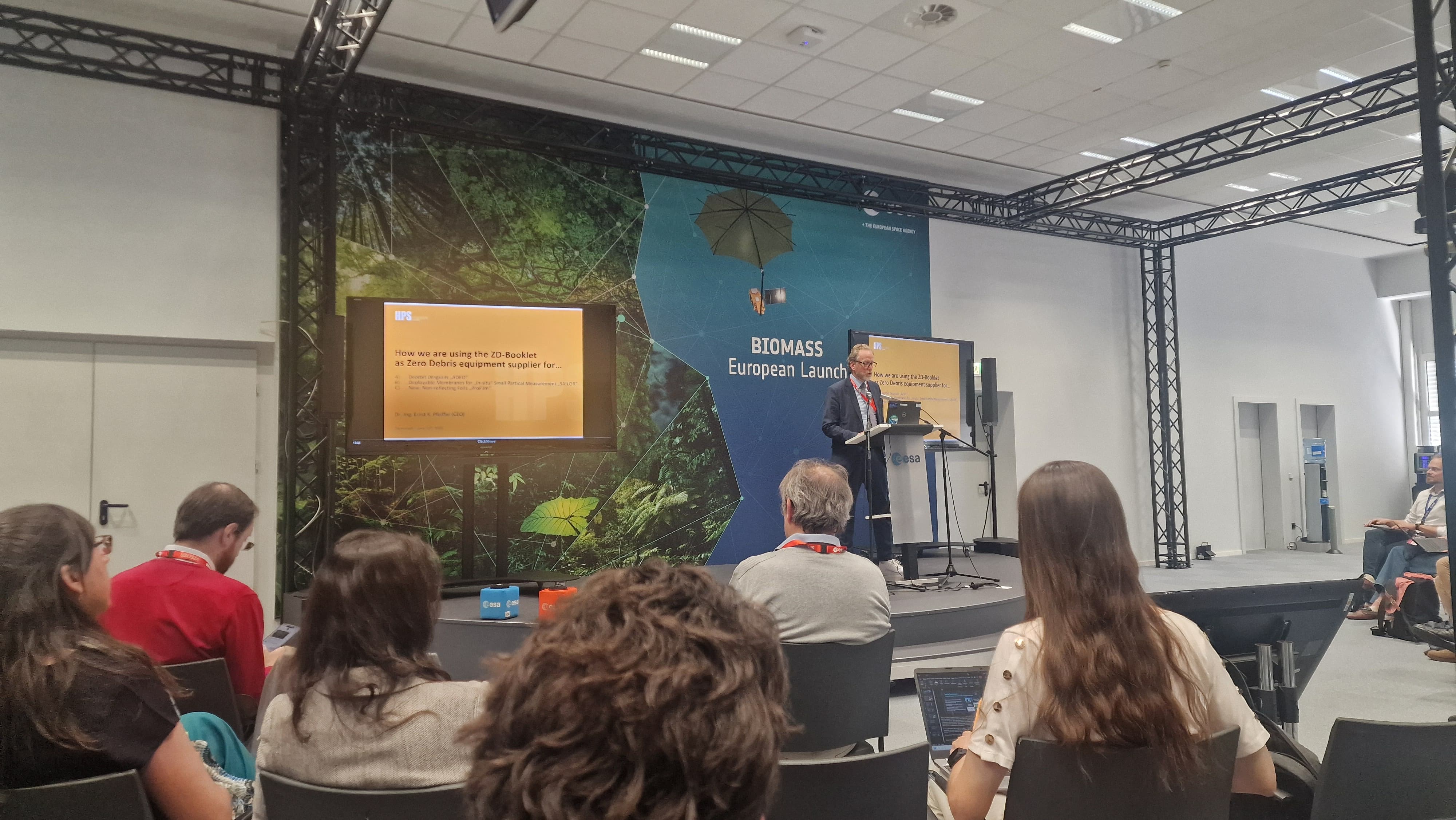

HPS prominently present at ESA’s Zero Debris Week
From 10 to 12 June 2025, everything at ESA’s European Space Operations Center in Darmstadt will be dominated by the highly ambitious “Zero Debris Program” of Europe’s space agency. The days are divided into two large action chapters: from June 10-11 at noon, the Zero Debris Future Symposium will focus in particular on high-level discussions of non-technical aspects, such as the future direction of the Zero Debris Initiative and its community, as well as commercial and political challenges in connection with orbital debris. Day two, June 11-12 at noon, will be dedicated to another working session on the Zero Debris Technical Booklet. Among other things, the technical leaders who will oversee the next edition of the booklet will be elected on this occasion. The participating organizations will also discuss how they have used the booklet so far, how the work on the booklet should be regulated and organized, and how the technologies listed in the booklet can be implemented.
The Zero Debris Technical Booklet published on January 15, 2025 lists technologies that ESA believes will contribute to achieving the goal of zero debris by 2030. The booklet is essentially a technical zero debris “to-do list”. The aim is to minimize the release of new debris and reduce its impact on people, infrastructure and the Earth’s environment.
Developed by a team of engineers, operators, lawyers, scientists and policy experts from a wide range of institutions in the Zero Debris community, the booklet identifies six key technology objectives that are essential to achieving Zero Debris goals:
- Preventing the release of new debris at any scale, from small particles to missile parts.
- Preventing the creation of debris from collisions or breakups.
- Improve monitoring and coordination of space traffic.
- Immediate evacuation of satellites from important low-Earth and geostationary orbits at the end of their mission.
- Preventing damage to the ground after re-entries.
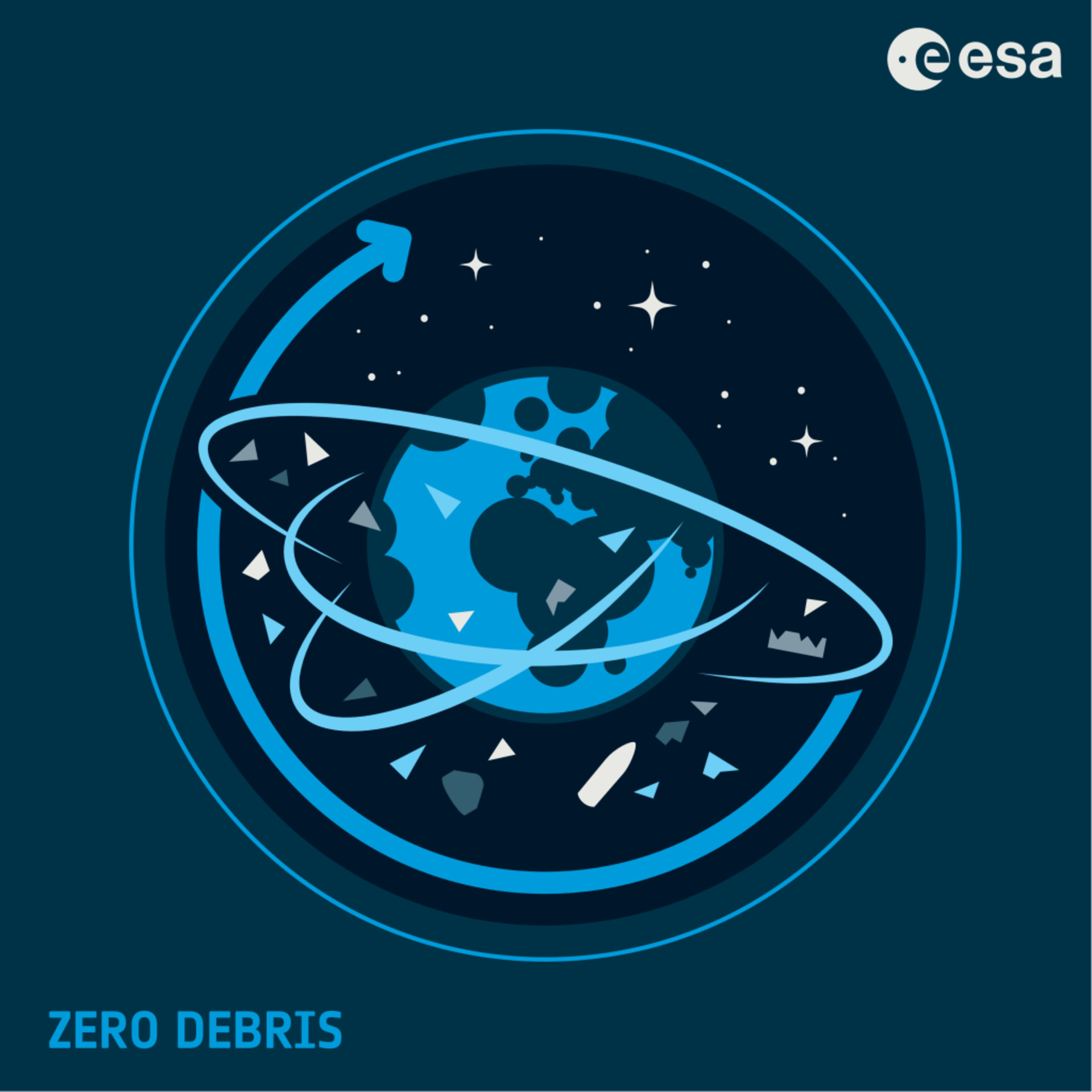
ESA itself is focusing its efforts on the development of debris-resistant materials and technologies, the design of satellites that can be easily removed from orbit and do not burn up on re-entry into the atmosphere, and finally the development of standardized interfaces for efficient removal in the event of a malfunction.
Beyond the satellite itself, the focus is also on new systems to remove all components of the launch vehicle from orbit. Another source of debris are small particles released by certain types of fuel and pyrotechnics in orbit during deployment. Alternatives are to be developed for this. The distribution of space debris around the Earth highlights the importance of collision avoidance measures. Once the satellites are in operation, much can be gained by optimizing collision avoidance processes and space traffic management. A key element is improving tracking capabilities for smaller, currently untrackable debris objects to refine risk assessment.
Operational practices can also be optimized, supported by new technologies to improve communication infrastructure and spacecraft health monitoring. At the end of a mission, the deorbit and re-entry process (for LEO and MEO satellites) and the impact on the environment need to be considered. Active debris removal services are required in orbit, as well as reducing the environmental impact of debris re-entry on the ocean and atmosphere, which will begin with further research.
Participation in ESA’s Zero Debris Initiative is a top priority for HPS – and accordingly, HPS CEO Ernst K. Pfeiffer will take part in the central program items on both days in Darmstadt. HPS’s commitment goes far beyond academic aspects, as the company has already made a remarkable contribution to avoiding space debris with its ADEO Deorbit Module product family by rapidly removing disused satellites from orbit; in addition, it is already on the threshold of Phase B with initial developments for a detector for previously undetectable particles from 0.1 to 10 mm in size called SAILOR.
The HPS boss doesn’t mince his words when it comes to emphasizing the importance of the ESA initiative: “The Zero-Debris Initiative is a start, but we are still a long way to our goal. We still have to reach an important milestone, and that is directly in the minds of the target groups: In parts of the space community, the debris issue is still seen as merely a green nice-to-have topic. This is absolutely wrong: it is an issue of great commercial interest and value, because if the littering of orbits continues at this rate, economically viable activities in space will soon be history – and that so before they have really taken off.”
HPS puts ADEO know-how at the service of ESA´s Hungarian Prime C3S
It seems to be a basic law of nature: Wherever and however humans are active, they end up producing large quantities of waste. To suppress the problem, many terrestrial areas, the oceans and, in recent decades, outer space itself have become dumping grounds. However, the latter in particular is now threatening to take radical revenge, as flying debris from previous space missions is increasingly becoming a threat to all other activities, especially in the most frequented orbits between 200 and 1200 kilometers.
While large debris such as burnt-out rocket stages are the easiest to detect and can be avoided by new guests in orbit, it is the small projectiles, flying with 5-10 km/s orbital speed, which have often shrunk below millimeter size as a result of previous fragmentations, that pose the greatest threats. Even one millimeter-sized debris impact can render a satellite inoperable. Emerging their threat further, their flux increases significantly as their size decreases, with the consequence that the much more frequent impacts of debris of this size can pose a far greater risk to space operations than the more dramatic catastrophic incidents.
However, only larger debris can be observed and tracked from the ground – but not in the critical range of 0.1 to 50 mm. Therefore, measurements in situ, i.e. directly in orbit, are urgently needed to make it possible to describe the Earth’s flying garbage dump with sufficient reliability in the first place. After critically weighing up the alternatives, ESA has turned its attention to a possible large-area detector based on the successful ADEO deorbit sails from HPS. If the sail membranes are now equipped with acoustic sensors and cameras on board, it will be possible to measure the dust flow in the required size range. The name of the project: SAILOR – Sail Array for Impact Logging in Orbit.
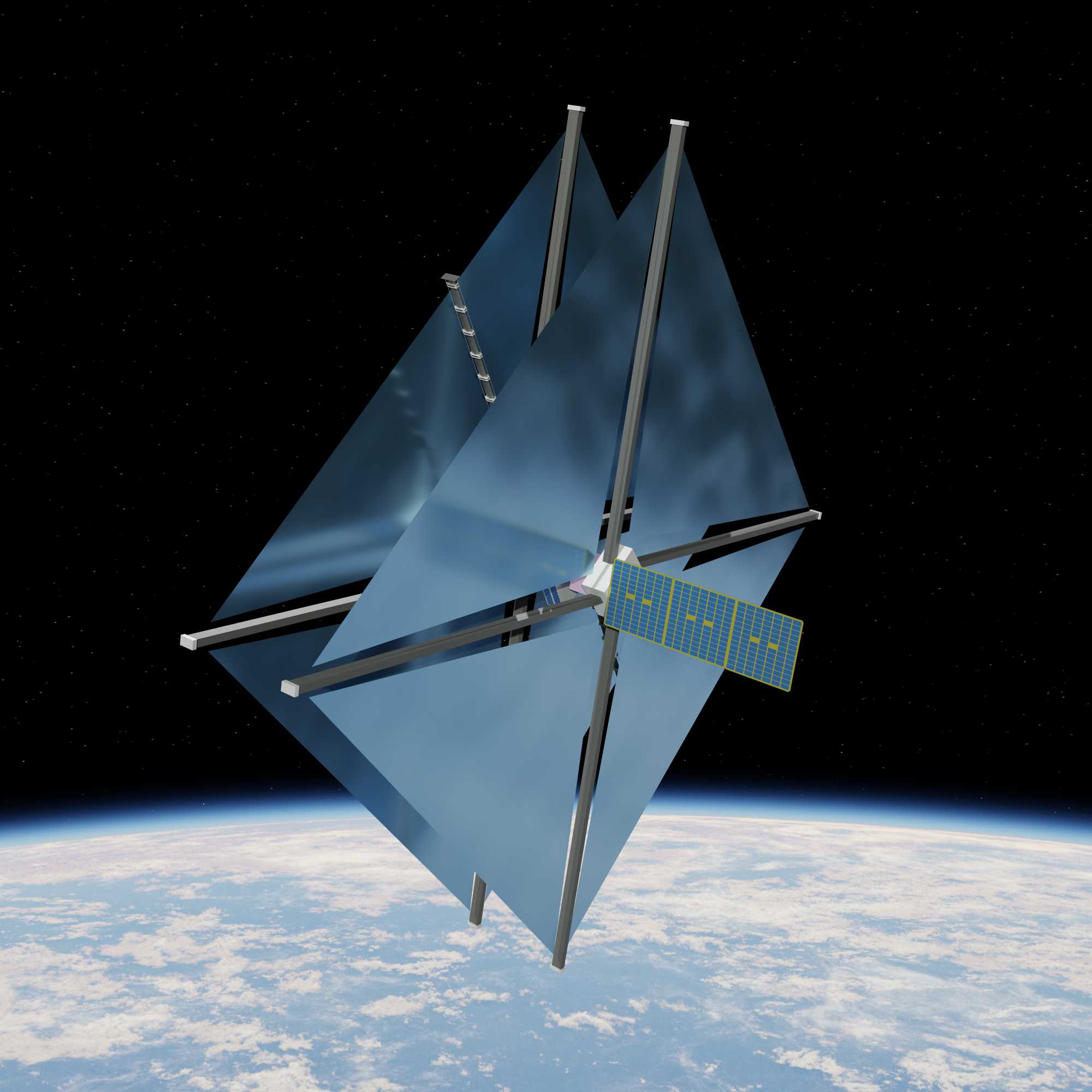
The spacecraft consists of two large detector surfaces 100 cm apart. The two sails have an exposed surface area of 25 m2; in the ADEO program, they are the main actors of the large dragsail versions under the name ADEO-L. The membranes are around 10 μm thick and are held in position by extendable cross booms. The booms are stowed together with the sail membranes during launch and deployed in orbit. The deployment module in which booms and sails are integrated, consists of a deploying mechanism with a motor that pushes the boom arms outwards. A system of multiple cameras is mounted to a separate boom to document the holes created on the inner surface of both sail membranes. Acoustic sensors are attached to the sails to detect an impact in real time. The interaction of SAILOR’s technical equipment will ultimately allow the density, speed and trajectory of the small debris to be determined.
The ambitious ESA project SAILOR is currently in the transition from Phase A to Phase B1, which will also include the construction of breadboard models of the spacecraft and its electronics as well as the associated test programs. It also involves these steps:
- Production of test samples of the proposed membrane equipped with the acoustic sensors
- Tests of sail folding for stowage
- Testing of the boom and sail deployment mechanisms
- A high-speed (hypervelocity) impact test program to test the sails and sensors
- Testing a camera system to image holes in the sail
- Preliminary design of the spacecraft including suppliers for all critical components and subsystems. PDR is currently planned to be achieved until 2028.
Overall, the specifications of the project in this phase should lead to a positive decision at the ESA Ministerial Council meeting in Bremen in November 2025 on the continuation of a three-year mission at an altitude of 850 km to be launched in 2031/2032. The industrial team proposes a small precursor CubeSat mission, called OPTIMIST after this type of sailboat, to test the sensor technology using an approx. 10 m2 membrane as early as 2027/2028 as risk mitigation for the full-scale mission.
The industrial structure behind SAILOR also stands for this. This is because C3S, a leading Hungarian aerospace company, is acting as prime contractor for an ESA project of this kind for the first time, drawing on the expertise of ADEO inventor HPS GmbH as a subcontractor for the deployable membrane subsystem. C3S is also planning work shares for HPS in Romania. HPS CEO Ernst K. Pfeiffer: “The great enthusiasm with which we have taken on our role in this project rests on three pillars: firstly, it is existentially important for the space industry as a whole; secondly, it is an opportunity for us as HPS to impressively demonstrate the versatility of the ADEO technology from our company; and thirdly, we consider it eminently important in Europe that the industrial talents of Hungary and Romania are finally brought to light in an appropriate way, and that in a joint mission. We at HPS are delighted to be working under the project management of C3S.”
HPS with ADEO product family: top position in NASA’s technology report extended
A year ago, the deorbit module from HPS took its place at the top of the podium of the most important technology achievements according to NASA. This was because ADEO already had everything that the American space agency considered crucial for success at the time: top values up to TRL9, scalability and proven flight heritage. Exactly one year later: ADEO, now supplemented in the technology report by the presentation of the bestsellers ADEO-Cube and ADEO-Pico, maintains its position both against numerous Dragsail competitors and against other passive deorbit technologies.
HPS CEO Ernst K. Pfeiffer comments: “With ADEO, we are surfing at the top of the wave worldwide that we have created ourselves with this technology over many years of R&D – often with significant co-financing by ESA and DLR plus considerable company resources. And we are actually delighted with every attempt by other companies to establish deorbit sails on the market: The bigger they make the wave, the higher our product family sails on its crest.”

January 2025
ADEO – Space Heritage
ADEO (Atmospheric Deorbit Sail Module) is the name for an entire product family of drag sails for satellites from the German space company HPS, Munich. They accelerate the disposal of satellites from space to a period of less than five years and thus fulfill the prerequisite for the satellite to receive approval for launch into space in the first place.
The sail is scalable and available in many variants from series production. ADEO-N is tailored to small satellite missions of 20-250 kg, while the ADEO-M and ADEO-L series are designed for larger missions of 100-700 kg and 500-1500 kg respectively. The ADEO-N series corresponds to a sail size of 5±2 m2, while ADEO-M covers areas of 15 ± 5 m2 and ADEO-L 25 m2 and more. However, smaller versions have also been available for a year, especially for cubesats, e.g. an ADEO-P for 1U-6U satellites (1-20 kg) and an ADEO-C for larger cubesats (5-50 kg). A total of five versions are currently available to order, all of which reliably dispose of satellites from LEO – including those from higher MEO orbits when combined with satellite’s onboard propulsion – within the required time frame. A corresponding configurator for selecting the perfectly suitable ADEO module is available for individual mission calculation (ADEO Online Configurator).
Now there is a short film about the production and testing of the product family, as well as ADEO’s heritage story:
Based on over ten years of development, HPS has successfully completed a series of missions up to “full burn” and has thus firmly established itself at the top of deorbit technologies at qualification level TRL 9.
2018: ADEO-N1 (“NABEO”) was launched on a Rocket Lab Electron rocket kick stage back in 2018, with Peter Beck himself (CEO RocketLab) even personally handling the sail. On this flight, the sail was unfurled just 90 minutes after the launch. Visual ground observations confirmed the successfully deployed sail and its performance.
2021: In June 2021, ADEO-N2 (“Show me your Wings”) was launched into space by the spacecraft carrier ION-003 of the Italian launch service provider D-Orbit, as part of SpaceX’s Transporter-2 mission. The successful deployment of the sail in December 2022 was recorded by the ION carrier’s on-board camera. The integrity of the sail after one year in orbit was confirmed, again by means of the onboard camera. On December 8, 2024, HPS received confirmation that ADEO-N2 had completed its mission with deployment of the dragsail at 506 km orbit altitude in a record time of just two years after the 210 kg satellite’s “end-of-business” with fireworks of success at 120 km orbit altitude, beating international rules and regulations by three full years.
Even NASA ranks the ADEO module from HPS as the number one automatic passive deorbit technology in view of the qualification and Flight Heritage.
ADEO is now a bestseller not only with European institutions and companies, but also in the fully commercial markets of the USA and Canada.
Highest qualification levels, proven reliability and flight heritage combined with scalability, availability and attractive pricing make the ADEO product family a highly visible beacon in the global field of deorbit systems for all satellites that must comply with the new 5-year deorbit requirement to obtain launch authorization.
Click here for the latest clip about ADEO
————————-
Video: © HPS GmbH, Munich, Germany, www.hps-gmbh.com
Production: Daniela Creutz, www.bluecirceproductions.com
————————-

WILD RIDE mission ends with fireworks of success for deorbit sail ADEO-N2
Three days ago, on December 8, 2024, HPS received confirmation that ADEO-N2 completed its mission with launch in 2021 and end-of-business with deployment of the dragsail at 506 km orbit altitude in December 2022 in a record time of only two years with a firework of success, beating international rules and regulations by three full years. This is further proof of the success of the German ADEO model, which is manufactured in series production by the German world market leader HPS for all sizes of LEO satellites in five ADEO versions. ADEO fulfils the “5-year rule” already issued by several states and organizations for obtaining launch and operating permits for satellites, and with “Wild Ride” this has now even been verified in orbit by precisely tracking the deorbit curve until the satellite burns up completely at an orbital altitude of approx. 127 km (see image).
About the mission:
On June 30, 2021, D-Orbit, a leading company in the space logistics and orbital transportation industry from Italy, announced the successful launch of another ION Satellite Carrier (ION SCV 003), its proprietary orbital transport vehicle. It lifted off at 9:31 p.m. CEST on June 30, 2021 atop a SpaceX Falcon 9 rocket from Space Launch Complex 40 (SLC-40) at Cape Canaveral Space Force Station (CCSFS), Florida. That same day, 60 minutes after launch, the vehicle was successfully placed into a 500 km high Sun Synchronous Orbit (SSO).
ION Satellite Carrier is a space transporter developed, manufactured and operated by D-Orbit. ION is capable of accommodating multiple satellites, transporting them into space, performing orbital maneuvers and precisely releasing them into dedicated orbital positions.
At the end of the so-called WILD RIDE mission, the ION SCV 003, weighing 210 kg at the time, entered the deorbit phase on December 15,2022 with the deployment of ADEO-N2 (effective sail size 3.6 m2, christened “Show me your Wings”) entered the deorbit phase and began testing the world’s first precise functional in-situ verification of a dragsail, with official “end of flight” on 08.12.2024 [source: NORAD], i.e. within exactly 2 years in a completely natural way and without exhaust gases from any propulsion system. Without sails, SCV-003’s deorbit would have taken twice to three times as long.
About ADEO:
ADEO-N is a 1U-sized deorbit sail module developed by the German space company HPS, in cooperation with several companies and institutions (e.g. DLR and Fraunhofer), co-funded by the ESA-GSTP program, the German national technology program, and the Bavarian technology program. In accordance with the new rules, ADEO ensures the removal of end-of-life satellites from LEO within a maximum of 5 years.
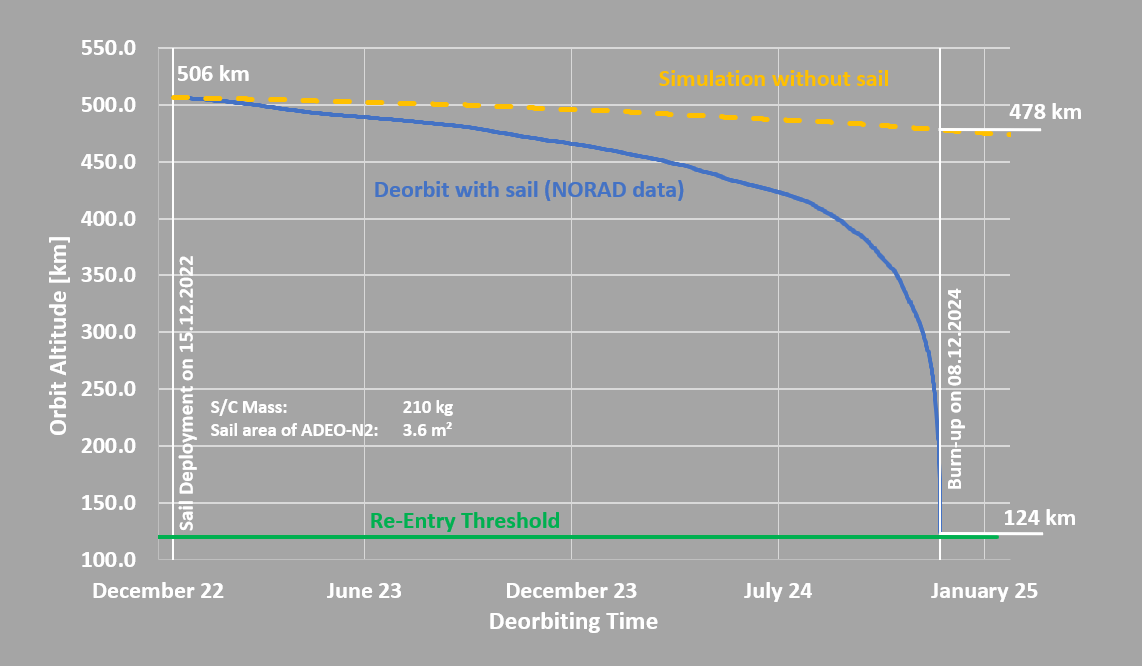
November 2024
HPS and EXOLAUNCH: Making Space Clean Again
HPS is happy to join forces with the Germany-based Exolaunch and is fully engaged to support customers of Exolaunch by enabling this very special and successful NewSpace-launch service provider to grant priority access to the delivery schedule of flight-proven ADEO* deorbit sails which are currently in high demand.
EXOLAUNCH’s COO Jeanne Allarie and HPS’s CEO Ernst Pfeiffer signed an Agreement on Space Tech Expo 2024 in Bremen in a great joint spirit (see pictures) the ambitious endeavour of
- being a role model for a sustainable use of space and
- of raising awareness with all potential customers on an existing solution for deorbiting: ADEO-modules are easy, affordable and reliable to contributing significantly to Making Space Clean Again.
See for the respective EXOLAUNCH announcement
(* ADEO-modules are needed to allow a satellite deorbit after its “End-of-Business” within five years; satellites without this or any kind of deorbit accelerator do not get clearance for launch anymore.)
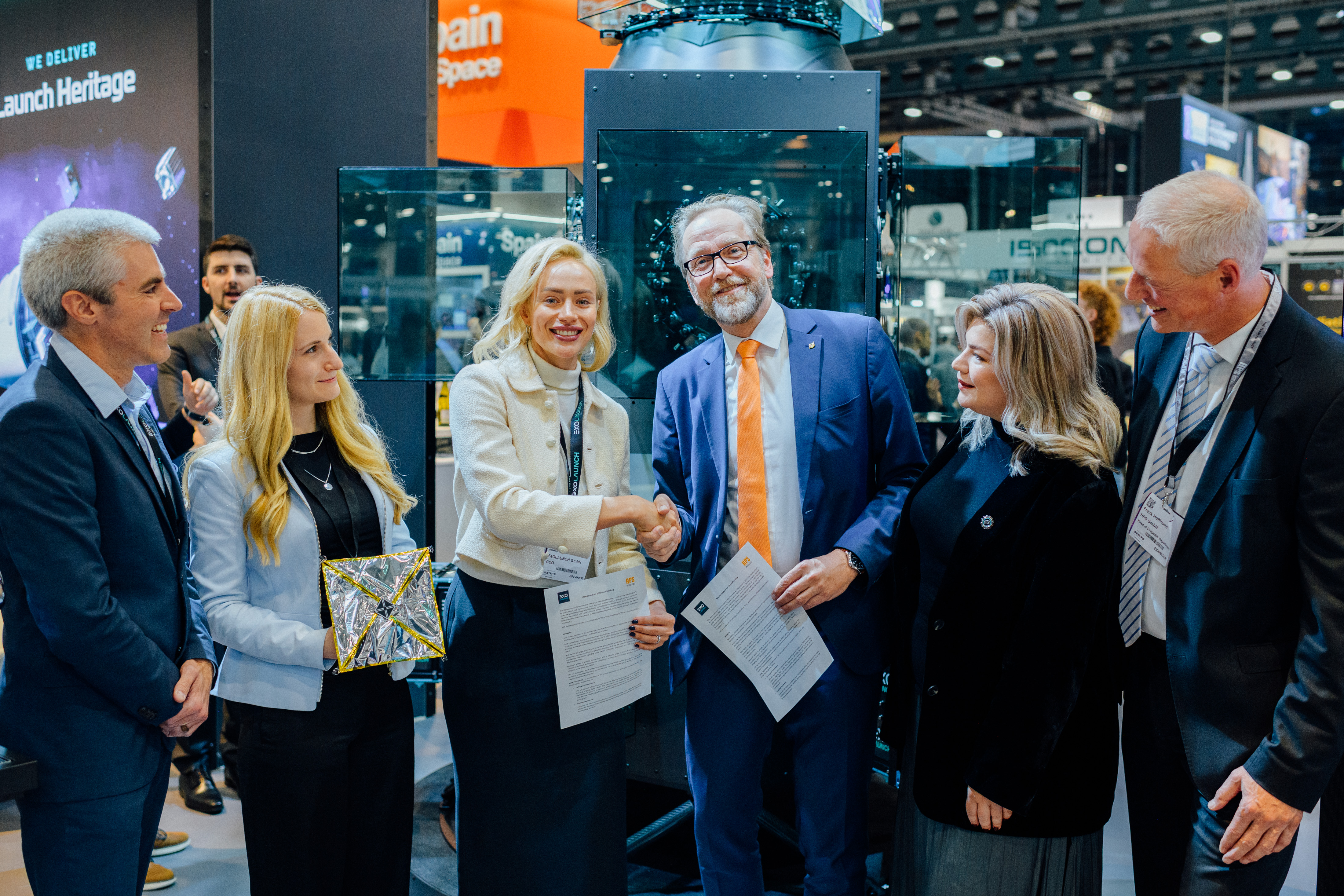


October 2024
Clean Space Days der ESA im Oktober: ADEO aus dem Hause HPS im Fokus
In 2024, the ESA’s Clean Space Team once again invited participants to the continuation of the past Clean Space Days.
The four-day event will focus on progress in the areas of eco-design, zero debris and in-orbit maintenance.
The calendar of presentations in 2024 will highlight these topics, among others:
- Life cycle assessment for space activities
- Deorbit technologies
- Debris disposal
- Disturbance-free skies for astronomy
- IOS missions
- Circular economy for space travel
While some presentations tended to highlight ideas and technical concepts in statu nascendi, HPS manager Frank Hoffmann presented the ADEO product family, which is already successful on the European and, more recently, North American markets: Deorbit sail technology for automatic self-disposal of the satellite at the end of the mission.
The ADEO system offers a suitably customized solution for every class of spacecraft, whether as a “Pico” (1-20 kg), “Cube” (5-50 kg), “Nano” (20-250 kg), “Medium” (100-700 kg) or even “Large” (500-1500 kg). To ensure that satellite manufacturers are supplied without delay, all orders are handled by HPS directly from series production wherever possible.
Due to the fact that the requirement to carry a suitable disposal system such as ADEO is a prerequisite for launch authorization for practically all satellites from October 2024, longer delivery times are possible and can be largely avoided by ordering early.
The Clean Space Days will come to an end at the end of the week, but the saying “after the event is before the event” also applies to this successful European space event.

